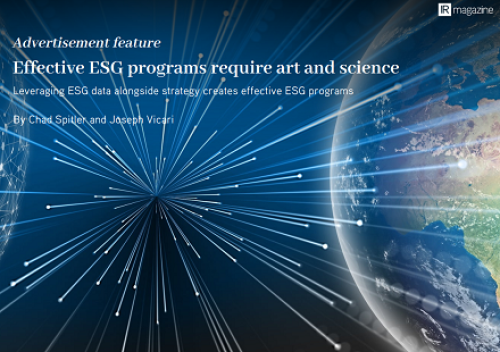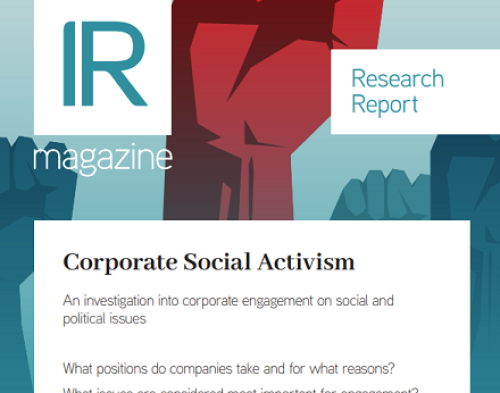Evidence of the link between investment returns and companies’ ESG commitments is mounting exponentially, showing that ESG should no longer be viewed as a fad and fueling scrutiny from asset managers. With this in mind, Curley Global IR (CGIR) in 2018 conducted research into ESG-related issues such as sustainability definitions, materiality and disclosure, issuer engagement and perspectives on current best practices.
CGIR’s data derives from detailed discussions with socially responsible investment (SRI)-focused portfolio managers and governance professionals, as well as public statements. Twenty-four asset management companies are included in the dataset, representing $17.1 trillion in assets under management.
CGIR asked questions relating to trends, internal resource allocation, engagement approach and use of indices and data aggregators. The goal was to identify whether ESG is as widespread as has been publicized, or whether it is a focus only for a ‘vocal minority’. The data reveals six key insights:
- Governance professionals and investor relations (IR) officers are struggling with the best way to handle ESG trends
- No single definition of sustainability exists, although asset managers use similar language, and all include ‘long term’
- Asset managers are investing heavily in SRI, adding personnel, enhancing training and dedicating budget dollars
- IR departments are the first – and preferred – point of contact
- There is a need for companies to outline what they believe is most material, coupled with a fear of SEC over-regulation
- Despite a desire for clarity, producing a ‘puppies and flowers’ ESG report is almost worse than producing nothing.
Sustainability and social media
Different constituents have different perspectives on sustainability. Asset managers look through one lens, issuers and environmental specialists another. No definition of sustainability has been widely adopted, but all touch upon long-term benefits.
As one asset manager says: ‘We believe we were the first firm to use the term sustainability as opposed to ESG. Our view of sustainability is how the company sustains its business model and cash flows into the foreseeable future for the long term. ESG is a backward-looking kind of measurement. Sustainability is more future-focused.’
The increased levels of ESG-related activity reinforce the need for understanding ESG practices. Who’d have imagined how social media would drive ESG disclosure? ESG hashtags abound on Twitter, and more than 57,000 ESG videos are available on YouTube.
All this outreach, communication and awareness forces us to ask: are we talking about the same subject? ‘ESG’ is a widely used term but can mean something different to governance professionals. Frameworks have been created recently with the aim of ensuring stakeholders understand the roles and responsibilities of companies and investors.
For example, the International Corporate Governance Network and Council of Institutional Investors have adopted ESG policies. The Sustainability Accounting Standards Board’s (SASB) principles have been adopted by proxy advisory firms and incorporated into voting assessments, although it acknowledges that ‘sustainability has no one-size-fits-all definition.’
An asset manager in CGIR’s research voices a similar sentiment: ‘We don’t use [the terms] interchangeably. We look at sustainability from a big-picture standpoint – the longevity of a company. We look at ESG [factors] as they pertain to material risks to the company.’
Investing in ESG
CGIR’s data shows a significant ESG commitment, in terms of human and financial resources, being made by asset managers. Investment institutions’ focus as fiduciaries is the biggest sign of ESG’s longevity. Several US-based firms indicate that they have named a head of sustainable investing in the past 18 months.
Asset managers expect issuers to outline what companies themselves believe is most material in terms of minimizing risk. SEC regulations require that when issues – including E, S and G – become ‘material and social well-being.’ A company’s ESG index is now a formal, reported measure, as companies face growing pressure for compliance with diversity goals, gender pay and climate risks.
Some asset managers have voiced a fear that if companies don’t provide meaningful disclosure, the SEC will mandate it. As the SEC reviews firms’ requests for no-action decisions on shareholder proposals, it may consider whether the current level of ESG disclosure is material for investors.
The role of the IRO and the board
CGIR’s study finds that – overwhelmingly – IR is the first point of contact for ESG questions. Questions are escalated as needed to the C-suite, the office of general counsel and/or the board of directors. A few firms state that they do not wish to speak with a chief sustainability officer (CSO), as their experience has not been productive.
One respondent says: ‘I’ve been reaching out to IR to get its assessment of ESG from a company standpoint. Because we are [United Nations-supported Principles for Responsible Investment] signatories, one of the initiatives is to get assessment from IR teams as to how they are progressing with integrated reporting as well as pushing SASB standards. We don’t deal with a CSO at all.’
A company’s ESG approach must be a topic that IR teams can discuss at a granular level – it’s no longer enough to simply provide low-level reports. CGIR’s research uncovers a disconnect between asset managers’ requests for ESG-related disclosure and boards’ views of ESG.
Investors now expect a board to convey how ESG factors affect the business and have been incorporated into the company’s strategy. Investors believe ESG factors are long term in nature, and strongly indicative of sustainability and risk mitigation. One investor respondent says it hurts companies when he reads sustainability reports and just sees ‘flowers and puppies.’
This raises red flags about the substance behind the report and how seriously the company takes its ESG responsibility. The respondent says: ‘We glance through [the reports]. With us, a lot of time is spent pre-meeting, and typically that would start with the annual report and, maybe, CSR reports. You learn how to skim past the fluff. If it’s just all fluff, then it raises concerns. It’s the ‘puppy index’: the more cute puppies I see in the report, the more concerned I am about the company.’
Issuers need a comprehensive framework
CGIR’s research shows it is time for public companies to have comprehensive ESG programs, including proper audit-control frameworks and communications plans. The program should yield data that is ‘reportable, repeatable and auditable.’
Investors are demanding enhanced public disclosures that must be backed up by fact. A company that provides significant disclosure of risks, long-term strategies and governance controls may be less of a target. Board members who can emphasize their roles in adopting ESG strategies may garner shareholder support.
Corporate leaders should identify tools to advance ESG initiatives and improve financial performance. Consider four areas when developing CSR/ESG plans:
- Assess what’s important and material to your key constituents. This helps to develop internal goals. For example, an asset manager’s client base will be a factor for shareholder engagement. One respondent states: ‘As fiduciaries, we take a pragmatic approach and we won’t take a stand on particular issues, but we go where the data goes. Even then, we are knee-deep in ESG’
- Consider adopting one of the established reporting frameworks as a blueprint for public disclosure
- Create a cross-functional internal committee that shares information, evaluates data for accuracy, and ensures reporting to the C-suite and board members
- Ensure that whatever ESG-related information is made public is material and important to various constituencies. A respondent notes: ‘We look at ESG [factors] as they pertain to material risks. We look at how [companies] are managing environmental risks and, ultimately, in the lens of that, broader sustainability. The same goes for the S and the G.’
Sally Curley is founder and CEO of Curley Global IR. Carol Nolan Drake is president and CEO of Carlow Consulting
This article originally appeared in the latest Corporate Secretary special report. Click here to view the full publication.










